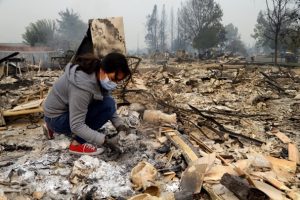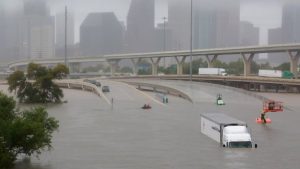 This has been a tough year for the planet and our climate. With rising air and sea temperatures across the globe, we’re seeing more intense hurricanes and wildfires. But the flooding from Hurricane Harvey in Houston and the devastating fires in California’s wine country are made worse by our land use patterns.
This has been a tough year for the planet and our climate. With rising air and sea temperatures across the globe, we’re seeing more intense hurricanes and wildfires. But the flooding from Hurricane Harvey in Houston and the devastating fires in California’s wine country are made worse by our land use patterns.
As I wrote about during the Harvey floods, the Houston sprawl exacerbated the damage by paving over natural floodplains that could have absorbed some of the excess rainwater. And now in the Napa and Sonoma wine country, we’re seeing sprawl neighborhoods of single-family homes adjacent to fire-prone wilderness areas taking the brunt of the destruction.
 Both types of disasters are going to become more common and intense in the coming years, as the planet warms even more. And that means we’re going to need to re-adjust our land development patterns with less sprawl and more infill.
Both types of disasters are going to become more common and intense in the coming years, as the planet warms even more. And that means we’re going to need to re-adjust our land development patterns with less sprawl and more infill.
In flood-prone areas, we’ll need more natural floodplains by concentrating development in the urban core and not allowing more sprawl. And in fire-prone areas, we’re going to need more defensible space between wildlands and sprawl, with more focused growth in our city centers that are protected somewhat from these fires by the urban ring.
How do we achieve these goals? Absent strong land use controls, such as urban growth boundaries and deregulation on local land use policies, we can achieve them through pricing. Examples include ending subsidized insurance for sprawl in flood- or fire-plains and levying higher fees on developments in these areas to cover the costs of the inevitable disasters.
Ultimately, more compact infill development and less sprawl will help make our cities and towns more resilient in the face of worsening climate change. It will take political will, perhaps motivated by these recent disasters, to get us there.
 Infill development offers many advantages for people: more housing, jobs and retail options closer to transit, so people don’t have to drive long distances; affordable rents and home prices as more housing is built to match demand; and climate and air quality benefits as less driving and paved open space means less pollution.
Infill development offers many advantages for people: more housing, jobs and retail options closer to transit, so people don’t have to drive long distances; affordable rents and home prices as more housing is built to match demand; and climate and air quality benefits as less driving and paved open space means less pollution.
But Hurricane Harvey and the destruction in Houston is now crystallizing another critical benefit of infill: resilience in the face of extreme weather events. As observers have noted, the devastating floods were exacerbated by land use policies that prioritized sprawl over flood control and “green infrastructure” that could have soaked up excess rainwater. More infill development would have saved this open space and avoided building homes that are now essentially destroyed and unlikely to be rebuilt.
Unfortunately, infill development is too often stymied by political barriers — not economic or environmental ones. As Paul Krugman described in an op-ed over the weekend:
In practice, however, policy all too often ends up being captured by interest groups. In sprawling cities, real-estate developers exert outsized influence, and the more these cities sprawl, the more powerful the developers get. In NIMBY cities, soaring prices make affluent homeowners even less willing to let newcomers in.
Krugman compared Houston to San Francisco as two sides of these extremes. Both cities will need infill as a climate resilience strategy: Houston for the flooding we just saw, and San Francisco in the face of sea level rise and more severe droughts (residents in infill developments use less water per capita), among other looming environmental challenges.
So perhaps one bright spot from this tragedy is that infill advocates can now point to Houston as a clear symbol of why infill is also an important adaptation strategy in a world with a rapidly changing climate.


